

Alright, make sure you're filming this and send a copy to my boss.
On this island, you will see big boobies, small boobies, mature
boobies, immature boobies, nesting boobies, masked boobies,
blue-footed boobies, booby chicks, so many different boobies!
Renato during our first briefing
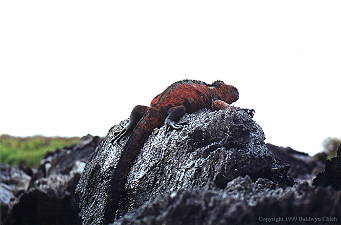
We land on Española at Punta Suárez, where we're greeted both by sea lions and the most colorful species of marine iguanas in the Galápagos (and hence, the world).
After a short hike, and we come across some nesting waved albatrosses. The largest bird in the Galápagos, this species of albatross is endemic to Española, and can have a wing span of over 7 feet. There are twelve thousand or so nesting pairs found on the Island, but they abandon the area during the warm months from January to March. These birds mate for life, but take separate vacations during this time.
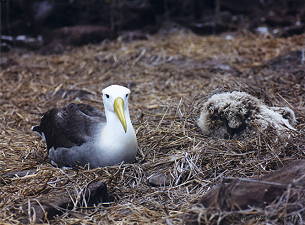
|

|
Continuing on the trail, we find an albatross airport. Because of their size, these birds have trouble both landing and taking off. The airport is used by the albatross to land, because it's fairly flat, and void of obstacles. They can take off by running, trying to gain enough speed to get off the ground, but here it's alot easier to just step off a cliff and glide.
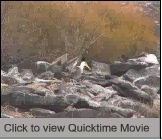
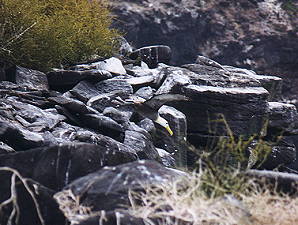
The coastline rises in tall rocky cliffs, and the day is windy and overcast. The scene is almost monochromatic, giving it a very remote feeling. Española IS remote, and in many ways like Genovesa. The southernmost island in the archipelago, it is a haven for several species of sea birds.

|
 |
Further down the trail, I realize what Barry Boyce and Renato meant as I step into booby-land. Blue-footed boobies are in such an abundance, we have to watch our feet to make sure we don't accidently step on one. I was hoping to catch some of the famous blue-footed booby mating rituals, and they certainly delivered! The males try to attract mates by showing off their blue feet, lifting them one by one to the females in the air. Another attention grabbing device, is the skypoint, where they stick their wingtips, beak and tail straight up towards the sky. This action is usually accompanied by a descending whistle. Once a female has been attracted, the male booby will present her with token pieces of nesting material, like branches. However, only the red-footed booby builds a nest. But, who are we to criticize their techniques, I have a friend who bought a thirty thousand dollar Mitsubishi thinking it would attract females.
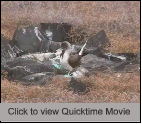


|

|
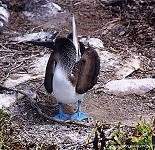
|
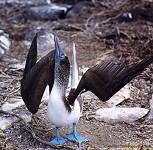
|
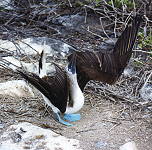
|
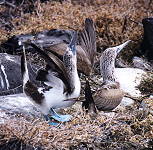
|
We step out of booby-land, straight into Albatross make-out point. These birds have a complex mating dance that can go on all day, and we really could have watched them all day! They raise their beaks high in military salutes, or ceremonially open and close their beaks in turn with a loud click. They rub their beaks together vigorously, or march gracefully, swinging their heads from left to right coyly.
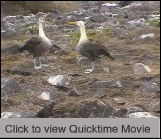
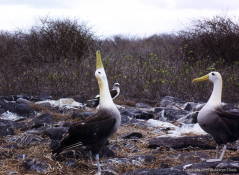
|

|

|
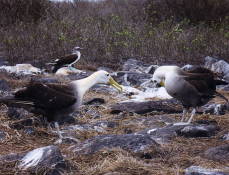
|
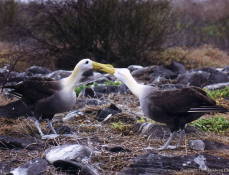
|

|
This island was perhaps my favourite in our visit. Being able to see the blue-footed boobies and waved albatrosses in action was a true thrill. Our visit to Punta Suárez ends too quickly, and we return to the Flamingo for our last snorkelling excursion, at Gardiner Bay. The waves were pretty strong this day, and after circling our snorkelling site, I elect to swim to beach to spend the rest of the afternoon. The sand is as powdery as sugar, and sea lions once again laze about the beach. One of the pups plays with sticks, and tries to rouse some of the adults to no avail.
Meanwhile, with my bright blue flippers donned, I try my own blue-foot dance to attract any boobies in the area.
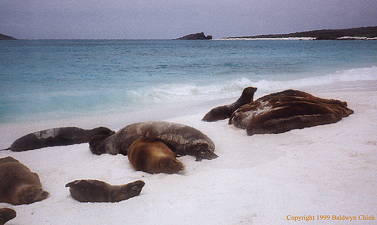
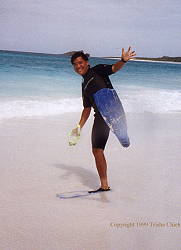
|
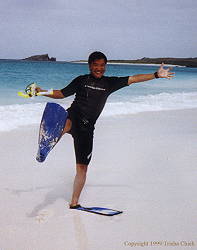
|
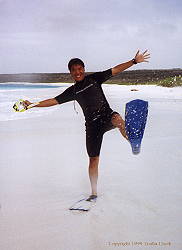
|